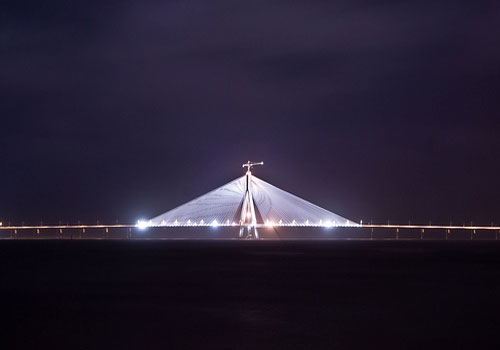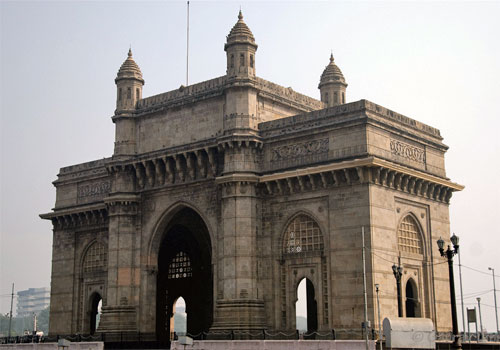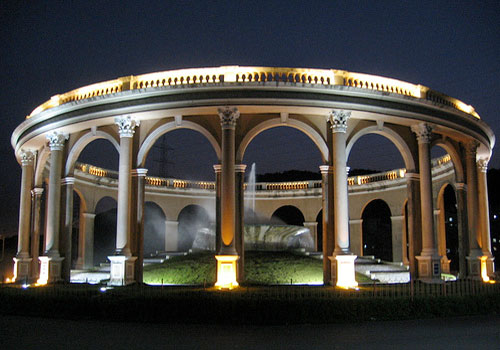Mumbai Travel Guide
Fort Area
Address: South Mumbai Mumbai
The magnificent Gothic Victorian buildings in Mumbai's Fort Area highlight the power and wealth of the British Empire at its might, and are reminiscent of many of the great public buildings in London or Glasgow. The Victoria Terminus (known as CST) was opened in 1888, and is one of the world's grandest railway stations, on a par with New York's Grand Central Station or London's St Pancras. Built in the Italian Gothic style, it looks more like a lavishly-decorated cathedral than a railway station: massive arches soar splendidly above the scurrying crowd, and carved into the pillars and buttresses are images of monkeys, peacocks, elephants and lions. The station is topped by a tall dome crowned with a statue representing Progress.<br /><br /> The nearby St Thomas' Cathedral was built between 1672 and 1718, standing witness to almost the entire history of the British in Bombay. Its whitewashed interior contains poignant colonial memorials - including one to Henry Robertson Bower, Lieutenant of the Royal Indian Marine, who lost his life returning from the South Pole with Captain Scott.<br /><br /> The epicentre of the Fort Area is Horniman Circle, which is surrounded by curved, arcaded terraces. The lush and leafy garden in the centre offers a welcome retreat from the hustle and bustle of the surrounding city.<br /><br />
Colaba
Address: Mumbai
The southernmost peninsula of Mumbai, known as Colaba, is where most travellers gravitate as it has a good range of hotels and restaurants and two of the city's most famous landmarks: the Gateway to India and the Taj Mahal Hotel. The Gateway to India was built in 1911 to commemorate the visit to India of King George V and Queen Mary. The archway is built from honey-coloured basalt in a style derived from Gujarati architecture of the 16th century. In the days of the steam liner, the Gateway was for many visitors their first and last sight of India, but today it acts purely as a colourful tourist stop, and attracts hawkers, snake charmers, and beggars. The neighbouring Taj Mahal Hotel was built in 1902 by JN Tata, after he was allegedly refused entry to one of the city's European hotels on account of being 'a native'. It has since turned into a bit of an institution, and the streets behind it have become a Mecca for foreign shoppers; the Colaba Causeway is the main street, with a melee of street vendors, shops, stalls and cafes.<br /><br /> Unfortunately Colaba was also the site of two of the 2008 Mumbai Attacks and tourists are recommended to remain vigilant when visiting the area. To the north of the causeway, set in beautiful lush gardens, is the fascinating Prince of Wales Museum displaying a collection of ancient and medieval sculpture and Indian decorative arts. Nearby, the new National Gallery of Modern Art showcases Indian modern art. To the south is the Sassoon Dock, which at dawn becomes an area of intense and pungent activity as fishing boats arrive to unload their catch.<br /><br />
Marine Drive
Address: Mumbai
Built in the 1920s, Marine Drive runs along the shoreline of the Arabian Sea, from Nariman Point to the foot of Malabar Hill. It is Mumbai's most famous thoroughfare, and a favourite spot for watching the sunset. Lined on the landward side by a crescent of crumbling Art Deco buildings, it is lit up memorably at night, prompting travel agents to dub it 'the Queen's Necklace'. At the top end of Marine Drive is Chowpatty Beach, the only beach in the central part of Mumbai. Though not ideal for sunbathing or swimming, it is a popular (though hectic) place to spend an afternoon, surrounded by beach traders, entertainers and beggars. It is the best place to watch the annual Ganesh Chaturthi Festival (during August/September), when vast models of Lord Ganesha are immersed in the sea. Marine Drive is also an exciting vantage point on Diwali, when there are stunning fireworks in the bay and all over the city. The thoroughfare is best avoided on weekends, when it can get extremely crowded and rather dirty, but the atmosphere is festive and some people love to mingle on busy days. There are many restaurants and cafes lining the street and it is lovely to either walk or drive along the road at night.<br /><br />
Crawford Market
Address: Junction of Dadabhoy Naoroji Road and Carnac Road Mumbai
The colourful indoor Crawford Market (Mahatma Jyotiba Phule Market) is where locals of central Mumbai go shopping for their fruit, vegetables and (for the brave) meat. Rudyard Kipling was born just south of the market, in 1865, and an ornate fountain designed by his father, Lockwood Kipling, sits between old fruit boxes at the market's centre. He also designed the frieze depicting Indian peasants in wheat fields which hangs above the main entrance. You can find almost anything at the market which is large and full of surprises. The animal market at the rear sells everything from poodles to parrots in small cages.<br /><br /> If you visit Crawford Market be sure to also have a wander around the area, particularly in the narrow lanes of Kalbadevi, north of the market. This predominantly Muslim area is a seething mass of people and traffic and is the location of several markets selling jewellery, textiles and leather goods. The most famous is the Chor Bazaar, Mumbai's 'thieves' market', which sells 'antiques' and miscellaneous junk - don't place too much faith in the authenticity of anything sold here. This area is also home to the Jama Masjid and the Mumbadevi Temple, which is dedicated to the patron goddess of the island's original Koli inhabitants.<br /><br />
Haji Ali Dargah
Address: Off the coast of Worli, near Mahalaxmi railway station Mumbai
The Haji Ali Dargah is both a mosque and a tomb, located in southwestern Mumbai, on an islet off the coast of Worli. The (tomb) was built in memory of Muslim preacher Syed Peer Haji Ali Shah Bukhari in 1431, who was inspired to change the course of his life after embarking on the Hajj to Mecca. Haji Ali is only accessible by a 1500-foot (457m) walkway during low tide. The walkway is generally lined with beggars and vendors, and Thursdays and Fridays see thousands of pilgrims flocking to Haji Ali to receive blessings from the dead saint. People of all religions are welcomed but the mosque is an important spiritual site for Muslims and some respect is due from visitors, who must abide by the mosque's rules - for instance, dress appropriately and use the separate entrances designated for women and men. As with many big attractions in Mumbai the site can get uncomfortably crowded and can be rather dirty, with beggars, touts and salesmen of all kinds thronging the place. The best time to visit is at low tide, early in the morning, as it is less crowded and the high tide washes away some of the rubbish. Although some people lament the crowds and dirt the Haji Ali Dargah is still a powerful and captivating site which impresses many.<br /><br />
Nehru Centre
Address: Dr Annie Besant Rd., Worli. Closest Railway Stations: Mumbai Central, Mahalakshmi, Dadar and Byculla. Mumbai
The exciting Nehru Centre, which even looks like a UFO, features a world-class planetarium, an art gallery filled with emerging talent, and an interesting culture wing. However, the highlight of the centre is the (permanent) Discovery of India exhibition, with consists of 14 galleries showcasing every aspect of artistic, intellectual and philosophical attainment in India through the ages; you walk through the history of India from ancient times to independence. This is a wonderful place to start for those looking to get to grips with the history and identity of India, one of the most mercurial and fascinating countries in the world. The centre is a tribute to its namesake, the first Prime Minister of an independent India, and described on the official website as a 'living testament and monument of faith in Jawaharlal Nehru's vision of man, his compassion for humanity, his concern for humanbeings and his undying passion to lift them to the greatest and highest purpose'. The planetarium is also very popular and offers well-planned and presented shows. There is a restaurant in the centre which has received good reviews from visitors.<br /><br />
Prince of Wales Museum
Address: 159/161 Mahatma Gandhi Rd Mumbai
The Prince of Wales Museum, now officially known as the Chhatrapati Shivaji Maharaj Vastu Sangrahalaya, was founded in the early 20th century to commemorate the visit of (eventual King of the United Kingdom) George V. The museum houses more than 50,000 exhibits of ancient Indian history, as well as artefacts from other lands. The museum's greatest areas of focus are art, archaeology and natural history. The Indus Valley Civilisation section is particularly impressive. The museum is surrounded by a lovely garden, which provides a nice area to stroll in after exploring the exhibitions. The building dates back to 1914 but it was originally used as a military hospital and only housed the museum in 1922; it is an acknowledged architectural gem of the city.<br /><br /> There is a cafe where visitors can buy refreshments and it's fun to enjoy them out in the garden. The museum's collection is fairly large and if you want to see everything you will need a few hours. Students should be sure to take their student cards along because the concession for foreign students is substantial. There is no air conditioning in the building so rather don't visit in the midday heat. You are allowed to take photographs for personal use, but there is an additional charge to take in a camera.<br /><br />
Mani Bhavan Gandhi Museum
Address: 19 Laburnam Rd Mumbai
The former home of Mahatma Gandhi, the Mani Bhavan Gandhi Museum is a Gujarati-style house featuring three floors for visitors to explore. The house did not belong to Gandhi but served as his home and headquarters in Bombay for 17 eventful years between 1917 and 1934; it belonged to a friend of his, who was his host whenever he visited the city. Several important events and activities in Gandhi's political life took place or were initiated at this place - he was arrested on the terrace in 1932. The museum houses an incredible library, full of Gandhi-related books, periodicals, photographs, posters and even the great man's old (spinning wheel). His old room has been preserved as it was when he lived in it, as far as possible, and there is a Picture Gallery and an Auditorium that plays Gandhi's speeches and films about him. The terrace where he once prayed, spoke and was arrested is open to the public. There is also a Sales Counter which sells memorabilia like stamps, photographs and books. For anybody interested in the life of this global icon the museum is a must, but it will probably bore young children or those who have no interest in history.<br /><br />
Dhobi Ghat
Address: Prakash Pathe Marg Mumbai
Known as the 'world's largest laundromat', the Dhobi Ghat provides a scene many travellers might have already seen in movies. Every day, thousands of (laundry washers) collect dirty laundry and descend upon the concrete washing areas, all fitted with their own flogging stones, to wash the garments. To the dhobis themselves, the washing and drying of clothes is a menial task - but to inquisitive tourists, this practise can be a fascinating insight into India's daily life, as well as a surviving relic of old India. The job is traditionally hereditary, and many of the men at work have families that have been doing the same job, and using the same age-old techniques, for generations. This is not a glamorous attraction but it is a very interesting one and many tourists love to photograph the work and the area and get a taste of the 'real' India. Having a local guide is an advantage because they can explain the history of the area and the job, and because they usually prevent the petty theft and pick-pocketing which sometimes occurs. Generally the people are very friendly and amused by the foreign interest in their menial labour but do watch your belongings carefully. Entrance to the area should be free but there have been reports of locals asking for a small admission price.<br /><br />
Elephanta Caves
Address: Elephanta Island Mumbai
Located on Elephanta Island, in the Arabian Sea off the coast of Mumbai, the Elephanta Caves are a UNESCO World Heritage Site and an absolute must for visitors to Mumbai. The island can be reached by an hour long boat ride from the Gateway of India pier. The caves feature (the oldest of the four sects of Hindusm) stone sculptures of Hindu deities important to worshippers of Shiva. Many of the sculptures in the caves were unfortunately defaced by the Portuguese who, in the 17th century, used the sculptures for target practice. However, there is still lots of intricate and impressive art to see. When you arrive and step off the ferry you walk through a gauntlet of vendors selling all sorts of food and trinkets. You can take a ride on a small train to get to the cave site, or you can opt to be carried up in chairs, although it is also possible to just walk. Each year, in February, the Elephanta Dance Festival is held outside the caves with lots of local dance troupes performing. The island can get very crowded on weekends and public holidays so it is best to go during the week if possible.<br /><br />
Kala Ghoda Bazaar
Address: Mumbai
For three months, between November and January each year, street musicians and performers of all kinds add to the colourful atmosphere of Mumbai's Sunday street bazaars, held near the Jehangir Art Gallery in the city's pedestrian plaza. The area becomes a hive of activity and excitement between November and January, with cultural performances and stalls selling a variety of crafts, folk art and food, but the stretch has become such a hub of cultural and artistic activity that it is now known as an art precinct all year round.<br /><br /> The Kala Ghoda Art Precinct stretches from Regal Circle at the southern end of Mahatma Gandhi Road, to Mumbai University, which is further north on the same street. The attractions along this stretch include the Mumbai National Gallery of Modern Art, the Prince of Wales Museum, the Jehanqir Art Gallery, the Kala Ghoda Pavement Gallery (where talented young artists exhibit their work on railings set up along the pavement), the Museum Gallery, and Rampart Row (a restored heritage building packed with stores and restaurants). The area also boasts some of the city's most popular restaurants and is a great place to go shopping and eating-out.<br /><br />
Joss
Address: 30 K Dubash Marg, Kalaghoda Mumbai
Food Type: Asian
This diverse restaurant specialises in Japanese, Malaysian, Indonesian and Balinese cuisine, and is a firm favourite when dining out in Mumbai. Dishes such as oriental crab bisque, Nonya bamboo chicken and Norwegian salmon flavoured with dill, lemon butter and crisp seaweed are not to be missed. For those with a sweet tooth, try the chocolate cigar with prune and Armagnac ice cream. Reservations recommended.<br /><br />
Rajdhani
Address: Level 2, Phoenix MarketCity, LBS Marg, Kurla Mumbai
Food Type: Indian
Serving traditional Rajasthani, Maharashtrian, Sindhi and Kathiawadi Thali, Rajdhani is a vegetarian restaurant popular with both locals and tourists. Traditional favourites such as roti and are not to be missed. Open daily for lunch and dinner. Closed on Sundays.<br /><br />
Jimmy Boy Restaurant
Address: 11 Bank Street, Vikas Building, Fort Mumbai
Food Type: Parsi/Iranian
An unusual restaurant, Jimmy Boy Restaurant serves Farsi and Iranian food, with favourites on the menu including the chicken dhansak and chicken jardaloo, which are both specialities here and probably the most flavourful dishes on the menu. This is a great place to sample some of the subcontinent's lesser-known fare. Open daily for lunch and dinner.<br /><br />
Trishna
Address: Birla Mansion, Sai Baba Marg, Kala Ghoda, Fort Area Mumbai
Food Type: Seafood
Popular with Mumbai's elite, Trishna has a formidable reputation, and prides itself on its seafood dishes. With a sister restaurant in London, a visit to Trishna is a must while in Mumbai, even if just to sample the flagship dish, the butter pepper garlic king crab. Open daily for lunch and dinner (dinner only on Sundays). Reservations essential.<br /><br />
Peshawri
Address: Sahar Airport Rd, Andheri East, Mumbai Mumbai
Food Type: Indian
Serving up northwestern Indian dishes inspired by the cuisine encountered by the British on the frontier in 1990, Peshawri is a firm favourite with travellers looking for an upmarket restaurant promising authentic Indian fare. The food is cooked in traditional 'tandoor' clay ovens and the ambience is friendly but sophisticated. Open daily for lunch and supper.<br /><br />



